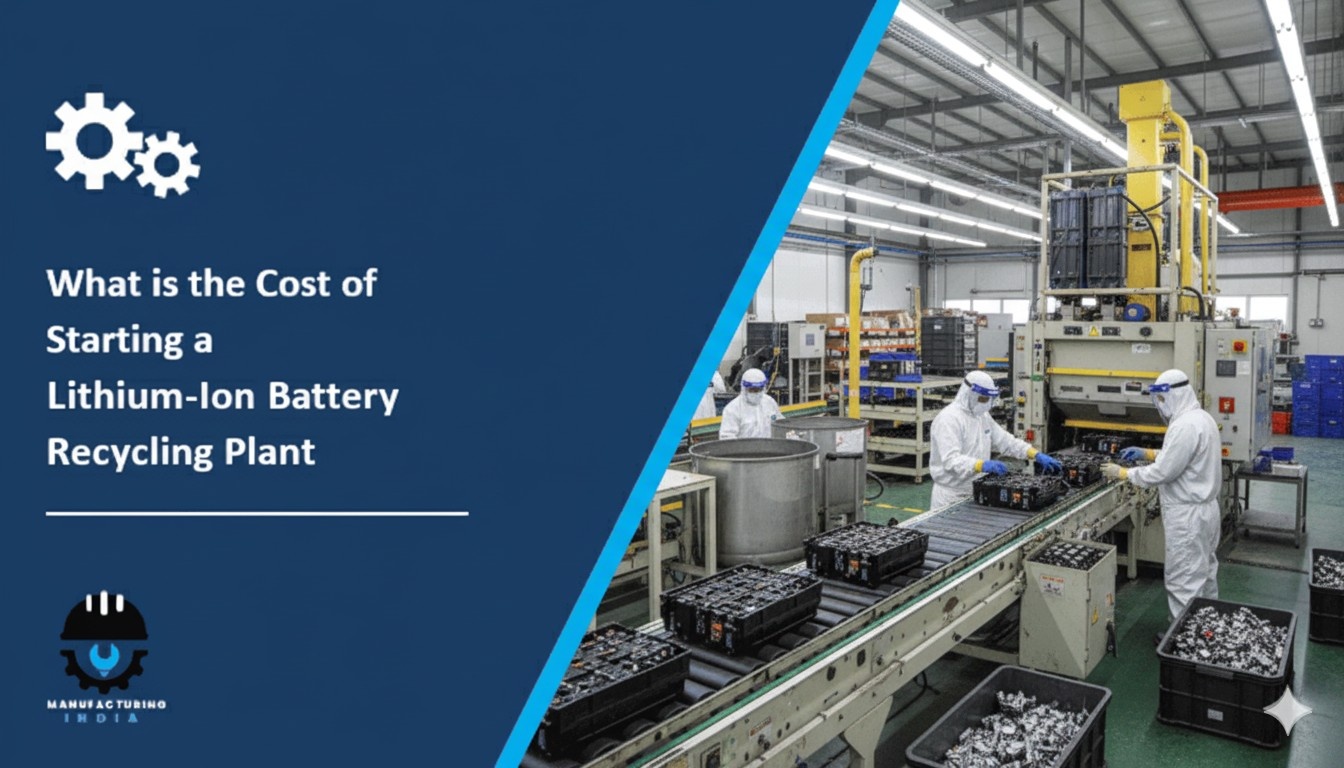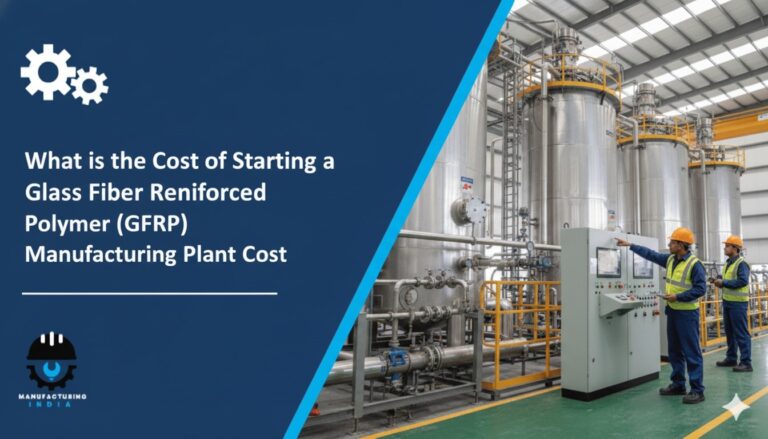
The lithium-ion battery recycling industry is rapidly emerging as a critical component of the circular economy, supporting electric vehicle adoption, renewable energy storage, and sustainable electronics manufacturing. With exponential growth in battery consumption and stringent environmental regulations, establishing a lithium-ion battery recycling plant presents a compelling business opportunity for forward-thinking entrepreneurs.
The battery recycling industry is capital-intensive yet essential, requiring advanced technology, environmental compliance, and careful planning. From collection infrastructure to hydrometallurgical processing, every phase demands precision and expertise. Businesses can streamline this process by leveraging professional consulting resources for feasibility analysis, cost estimations, and technical requirements assessment.
Step-by-Step Guide to Setup Lithium-Ion Battery Recycling Facility
Step 1: Conducting Market Research and Feasibility Study
Analyzing the Market:
Beyond traditional battery waste streams, enterprises should explore emerging opportunities in electric vehicle battery retirement, consumer electronics recycling, and industrial energy storage system decommissioning. The industry is experiencing rapid growth as manufacturers seek sustainable sources of critical minerals.
Sustainability drives this sector, with demand for recovered lithium, cobalt, nickel, and manganese increasing substantially. Leading recyclers have announced initiatives for achieving battery-grade material recovery and establishing closed-loop supply chains with battery manufacturers.
Analyze strategies employed by established battery recyclers globally, focusing on advanced separation technologies, pyrometallurgical and hydrometallurgical processes, and direct recycling innovations. These technologies enable high recovery rates and minimal environmental impact.
Businesses must monitor regulatory developments, technological advancements, and industry partnerships to maintain competitive advantage. Regional factors significantly impact plant viability—facilities near electric vehicle manufacturing hubs benefit from steady battery supply, while those in electronics manufacturing regions access diverse waste streams.
Estimate capital requirements for land acquisition, specialized equipment installation, environmental control systems, collection network development, and research capabilities. Recent industry investments highlight substantial financial commitments required for competitive operations.
Step 2: Business Plan Development
Include comprehensive financial modeling covering initial investment, operational expenses, and revenue streams from recovered materials. Address sustainability certifications and environmental initiatives that attract automotive manufacturers and electronics companies as strategic partners.
Business Model: Determine whether to focus on automotive battery recycling, consumer electronics batteries, industrial battery systems, or integrated multi-stream processing facilities, and develop business strategies accordingly.
Funding Strategy: Outline potential funding sources including private equity focused on circular economy ventures, green bonds, government grants for sustainable manufacturing, or strategic partnerships with battery manufacturers and automotive companies.
Production Capacity: Define target processing volume based on waste stream availability and capital resources, considering small-scale operations or large-scale industrial facilities capable of processing thousands of tons annually.
Marketing and Sales Strategy: Develop plans for establishing collection networks, partnership agreements with automotive dealerships and electronics retailers, direct contracts with battery manufacturers, and positioning as preferred recycling partner through environmental certifications.
Risk Assessment: Identify potential challenges including material price volatility, technology obsolescence risks, regulatory compliance complexities, supply chain disruptions in waste battery collection, and propose comprehensive mitigation strategies.
Step 3: Navigating Legal Requirements and Obtaining Necessary Permits
Compliance with stringent regulatory frameworks is essential for battery recycling operations. Key requirements include:
Business Registration: Establish company structure compliant with manufacturing and hazardous waste management regulations in your jurisdiction.
Environmental Approvals: Obtain comprehensive environmental clearances covering hazardous waste handling, air emissions from thermal processes, wastewater treatment, and solid waste disposal permissions.
Hazardous Waste Licenses: Secure specialized licenses for collecting, transporting, storing, and processing hazardous materials including battery electrolytes, heavy metals, and chemical reagents.
Safety Certifications: Implement workplace safety protocols addressing chemical exposure, fire hazards from lithium batteries, and emergency response procedures. Obtain industrial safety board approvals and occupational health certifications.
Quality Certifications: Pursue ISO certifications for quality management, environmental management systems, and occupational health and safety, along with industry-specific certifications demonstrating responsible recycling practices.
Step 4: Selecting an Optimal Location and Develop Infrastructure
Location selection critically impacts operational efficiency and regulatory compliance. Consider:
Proximity to Battery Sources: Access to collection points including automotive dealerships, electronics retailers, battery manufacturers, electric vehicle service centers, and industrial facilities ensures steady feedstock supply and reduces transportation costs.
Logistics and Transportation: Ensure excellent connectivity to major transportation networks for safely handling hazardous materials. Specialized transportation infrastructure for battery collection and recovered material distribution is essential.
Utilities Availability: Reliable electricity supply for processing equipment, adequate industrial water for hydrometallurgical operations, chemical storage facilities, wastewater treatment infrastructure, and emergency response capabilities.
Land Requirements: Sufficient space for receiving and sorting areas, battery discharge and dismantling sections, mechanical processing facilities, chemical processing units, materials storage with proper containment, quality control laboratories, and administrative offices. Typical requirement varies based on processing capacity and technology employed.
Step 5: Procuring Advanced Machinery and Quality Raw Materials
Investing in specialized recycling technology ensures efficient recovery and environmental compliance. Essential equipment includes:
Collection and Sorting Systems:
- Battery collection containers and transport systems
- Automated sorting equipment for battery type identification
- X-ray or laser-based battery composition analyzers
- Conveyor systems with safety interlocks
Discharge and Dismantling Equipment:
- Safe discharge systems for residual energy removal
- Automated or semi-automated dismantling lines
- Electrolyte drainage and collection systems
- Protective enclosures for hazardous material handling
Mechanical Processing Systems:
- Shredding equipment designed for battery materials
- Crushing and grinding mills
- Magnetic separators for ferrous material recovery
- Air classification systems for material separation
- Sieving and screening equipment
Thermal Processing Equipment:
- Pyrolysis or calcination furnaces for organic component removal
- Temperature control and monitoring systems
- Off-gas treatment and emission control equipment
- Heat recovery systems
Chemical Processing Systems:
- Leaching reactors for metal extraction
- Solvent extraction equipment
- Precipitation and crystallization vessels
- Filtration and separation systems
- Purification equipment for battery-grade material production
Environmental Control Equipment:
- Scrubbers and fume extraction systems
- Wastewater treatment plants
- Air quality monitoring equipment
- Containment systems for hazardous materials
Quality Control Equipment:
- Inductively coupled plasma spectrometers
- X-ray fluorescence analyzers
- Material purity testing equipment
- Electrochemical testing systems
Chemical and Material Requirements:
- Acids and bases for leaching processes
- Organic solvents for extraction
- Precipitating agents
- Neutralizing chemicals
- Packaging materials for recovered products
- Personal protective equipment and safety supplies
Step 6: Building a Skilled Workforce
Recruiting qualified personnel with specialized expertise is vital for safe and efficient operations. Key roles include:
Technical Leadership:
- Chemical engineers and metallurgists specializing in extraction processes, process optimization, and recovered material quality assurance
- Environmental engineers for emissions control and waste management
- Battery technology specialists for safe handling procedures
Operations Team:
- Battery dismantling technicians trained in safe handling protocols
- Process operators for mechanical and chemical processing
- Equipment maintenance technicians
- Materials handling specialists
Quality Control:
- Laboratory analysts for material characterization and purity verification
- Quality assurance managers ensuring recovered materials meet battery manufacturer specifications
Research & Development:
- Process development engineers for improving recovery rates
- Innovation team exploring direct recycling and advanced separation technologies
Support Functions:
- Environmental compliance officers ensuring regulatory adherence
- Safety managers implementing comprehensive hazard prevention programs
- Logistics coordinators managing collection networks
- Sales professionals building partnerships with battery manufacturers
Industry leaders maintain comprehensive training programs covering chemical safety, battery hazards, emergency response, and process optimization.
Step 7: Implementing the Production Process
The battery recycling process involves carefully controlled stages:
Collection and Reception:
- Battery collection from various sources with proper documentation
- Transportation in compliance with hazardous materials regulations
- Initial inspection and classification by chemistry type
- Quarantine period for damaged or compromised batteries
Discharge and Safety Preparation:
- Safe discharge of residual electrical energy
- Battery voltage verification
- Electrolyte extraction where applicable
- Preliminary dismantling of packaging and casings
Mechanical Processing:
- Shredding or crushing in controlled atmosphere
- Material separation using magnetic, gravity, and air classification
- Recovery of steel, aluminum, and copper components
- Black mass collection containing active materials
Thermal Treatment:
- Pyrolysis for organic component removal including binders and electrolytes
- Temperature-controlled calcination
- Off-gas capture and treatment
- Preparation for chemical processing
Chemical Processing:
- Leaching of black mass using acid or alkaline solutions
- Selective extraction of lithium, cobalt, nickel, and manganese
- Solvent extraction for metal purification
- Precipitation to recover individual metals
- Crystallization for battery-grade compound production
Purification and Refinement:
- Multiple purification cycles achieving battery manufacturer specifications
- Removal of impurities and contaminants
- Drying and particle size control
- Quality testing at each stage
Quality Verification:
- Chemical composition analysis
- Purity testing to battery-grade specifications
- Particle size distribution measurement
- Electrochemical performance testing
- Certification documentation
Packaging and Distribution:
- Packaging in appropriate containers meeting transport regulations
- Detailed labeling with material specifications
- Documentation for traceability
- Storage under controlled conditions
- Distribution to battery manufacturers and chemical companies
Step 8: Establishing Marketing and Distribution Channels
Building strong partnerships is essential for sustainable operations and material sales:
Direct Partnership Channels:
- Electric vehicle manufacturers seeking sustainable material sources
- Battery manufacturers implementing circular economy initiatives
- Electronics manufacturers with product stewardship programs
- Energy storage system developers
Supply Chain Integration:
- Long-term supply agreements with automotive companies
- Material take-back programs with battery producers
- Closed-loop partnerships ensuring material returns to production
- Export opportunities to international battery manufacturers
Collection Network Development:
- Partnerships with automotive dealerships and service centers
- Collection agreements with electronics retailers
- Municipal waste management collaborations
- Industrial battery retirement programs
Marketing Strategies:
- Sustainability certifications and responsible recycling credentials
- Technical documentation demonstrating material quality
- Participation in circular economy and sustainability forums
- Case studies showcasing successful material recovery
- Digital presence highlighting environmental impact
Value Proposition:
- Competitive pricing for recovered materials versus virgin resources
- Consistent material quality and supply reliability
- Reduced carbon footprint compared to mining operations
- Regulatory compliance support for battery manufacturers
- Traceability and responsible sourcing documentation
Step 9: Ensuring Compliance with Safety and Environmental Standards
Battery recycling involves significant hazards requiring rigorous compliance measures:
Worker Safety:
- Comprehensive training on lithium battery fire risks and chemical hazards
- Personal protective equipment including respirators, chemical-resistant clothing, and eye protection
- Emergency response procedures for thermal runaway events
- Regular safety audits and equipment inspections
- Controlled atmosphere work areas for fire prevention
Fire Prevention and Response:
- Battery storage in fire-resistant containers with temperature monitoring
- Inert atmosphere systems for processing areas
- Automatic fire suppression systems
- Emergency cooling systems for thermal events
- Evacuation procedures and emergency equipment
Environmental Compliance:
- Air emission monitoring and control for process operations
- Wastewater treatment meeting discharge standards
- Hazardous waste manifesting and proper disposal
- Soil and groundwater monitoring programs
- Regular environmental reporting to regulatory authorities
Chemical Safety:
- Proper storage and handling of acids, bases, and organic solvents
- Secondary containment for chemical storage areas
- Material compatibility assessments
- Spill prevention and response procedures
- Chemical inventory management systems
Transportation Safety:
- Compliance with hazardous materials transportation regulations
- Proper packaging and labeling of battery shipments
- Driver training and certification programs
- Emergency response planning for transportation incidents
Environmental regulations for battery recycling continue tightening globally. Leading recyclers invest substantially in emission control technologies, closed-loop water systems, and zero-discharge operations to exceed compliance requirements.
Step 10: Planning for Future Expansion and Innovation
Once operations stabilize, focus on scaling and technological advancement:
Increasing Processing Capacity:
- Facility expansion to accommodate growing battery retirement volumes
- Additional processing lines for different battery chemistries
- Regional facility establishment near major battery consumption markets
- Mobile processing units for remote collection
Technology Advancement:
- Direct recycling technologies preserving cathode structure
- Enhanced recovery processes for higher yields
- Automation and robotics for improved safety and efficiency
- AI-driven sorting and quality control systems
Diversification:
- Processing new battery chemistries including solid-state batteries
- Expansion into other battery types like nickel-metal hydride or lead-acid
- Forward integration into cathode material manufacturing
- Development of second-life battery applications before recycling
Strategic Partnerships:
- Joint ventures with battery manufacturers for captive recycling
- Technology licensing agreements
- Research collaborations with universities and national laboratories
- Investment in battery collection infrastructure development
Circular Economy Leadership:
- Battery passport implementation for lifecycle tracking
- Design-for-recycling consultation with battery manufacturers
- Extended producer responsibility program development
- Industry standard setting for responsible recycling practices
Sustainability Excellence:
- Carbon-neutral operations through renewable energy
- Water recycling and zero liquid discharge systems
- Packaging waste reduction initiatives
- Life cycle assessments demonstrating environmental benefits



